Optimizing the Management of Cadmium Bioremediation Capacity of Metal-Resistant Pseudomonas sp. Strain Al-Dhabi-126 Isolated from the Industrial City of Saudi Arabian Environment
Abstract
1. Introduction
2. Materials and Methods
2.1. Sample Collection
2.2. Primary Screening of Cd Resistant Bacteria
2.3. Evaluation of Minimum Inhibitory Concentration
2.4. Cadmium Removal Assay
2.5. Identification of Bacteria
3. Results and Discussion
3.1. Screening of Cd Resistant Bacteria
3.2. Relative Growth of Bacteria on LB Medium at Various Concentrations of Cd
3.3. Bacterial Strains and Colony Morphology
3.4. Bioremediation of Cd by the Bacterial Isolates
3.5. Effect of Temperature on Cd Removal by Bacterial Strain
3.6. Effect of pH on Cd Removal by Pseudomonas sp. Al-Dhabi 126
4. Conclusions
Author Contributions
Funding
Acknowledgments
Conflicts of Interest
References
- Balasubramanian, T. Heavy metal contamination and risk assessment in the marine environment of Arabian Sea, along the southwest coast of India. Am. J. Chem. 2012, 2, 191–208. [Google Scholar]
- Tang, X.; Zeng, G.; Fan, C.; Zhou, M.; Tang, L.; Zhu, J.; Wan, J.; Huang, D.; Chen, M.; Xu, P.; et al. Chromosomal expression of CadR on Pseudomonas aeruginosa for the removal of Cd (II) from aqueous solutions. Sci. Environ. 2018, 636, 1355–1361. [Google Scholar] [CrossRef]
- Ali, H.; Khan, E.; Ilahi, I. Environmental chemistry and ecotoxicology of hazardous heavy metals: Environmental persistence, toxicity, and bioaccumulation. J. Chem. 2019, 2019, 6730305. [Google Scholar] [CrossRef]
- Kabata-Pendias, A.; Pendias, H. Trace Elements in Soils and Plants; CRC Press: London, UK, 2001. [Google Scholar]
- Feng, J.; Shi, Q.; Wang, X.; Wei, M.; Yang, F.; Xu, H. Silicon supplementation ameliorated the inhibition of photosynthesis and nitrate metabolism by cadmium (Cd) toxicity in Cucumis sativus L. Sci. Hortic. 2010, 123, 521–530. [Google Scholar] [CrossRef]
- Mortaheb, R.H.; Kosuge, H.; Mokhtarani, B.; Amini, M.H.; Banihashemi, H.R. Study onremoval of cadmium from wastewater by emulsion liquid membrane. J. Hazard. Mater. 2009, 165, 630–636. [Google Scholar] [CrossRef]
- Mahajan, P.; Kaushal, J. Role of Phytoremediation in Reducing Cadmium Toxicity in Soil and Water. J. Toxicol. 2018, 2018, 16. [Google Scholar] [CrossRef]
- Joutey, N.T.; Sayel, H.; Bahafid, W.; El Ghachtouli, N. Mechanisms of hexavalent chromium resistance and removal by microorganisms. Rev. Environ. Contamin. Toxicol. 2015, 233, 45–69. [Google Scholar]
- Oves, M.; Khan, M.S.; Zaidi, A. Biosorption of heavy metals by Bacillus thuringiensis strain OSM29 originating from industrial effluent contaminated north Indian soil. Saudi J. Biol. Sci. 2013, 20, 121–129. [Google Scholar] [CrossRef] [PubMed]
- Goksungur, Y.; Üren, S.; Güvenç, U. Biosorption of cadmium and lead ions by ethanol treated waste baker’s yeast biomass. Bioresour. Technol. 2005, 96, 103–109. [Google Scholar] [CrossRef] [PubMed]
- Xu, S.; Xing, Y.; Liu, S.; Hao, X.; Chen, W.; Huang, Q. Characterization of Cd2+ biosorption by Pseudomonas sp. strain 375, a novel biosorbent isolated from soil polluted with heavy metals in Southern China. Chemosphere 2020, 240, 124893. [Google Scholar] [CrossRef] [PubMed]
- Karimpour, M.; Ashrafi, S.D.; Taghavi, K.; Mojtahedi, A.; Roohbakhsh, E.; Naghipour, D. Adsorption of cadmium and lead onto live and dead cell mass of Pseudomonas aeruginosa: A dataset. Data Brief. 2018, 18, 1185–1192. [Google Scholar] [CrossRef] [PubMed]
- Zeng, X.X.; Tang, J.X.; Liu, X.D.; Jiang, P. Isolation, identification and characterization of cadmium-resistant Pseudomonas aeruginosa strain E 1. J. Cent. South Univ. Technol. 2009, 16, 416–421. [Google Scholar] [CrossRef]
- Peter, A.K.; Kocsis, B.; Kilar, F.; Pernyeszi, T. Bio-adsorption characteristics of Pseudomonas aeruginosa PAO1. J. Serb. Chem. Soc. 2014, 79, 495–508. [Google Scholar] [CrossRef]
- Sinha, S.; Mukherjee, S.K. Pseudomonas aeruginosa KUCd1, a possible candidate for cadmium bioremediation. Braz. J. Microbiol. 2009, 40, 655–662. [Google Scholar] [CrossRef]
- Kermani, A.N.; Ghasemi, M.; Khosravan, A.; Farahmand, A.; Shakibaie, M. Cadmium bioremediation by metal-resistant mutated bacteria isolated from active sludge of industrial effluent. J. Environ. Health Sci. Eng. 2010, 7, 279–286. [Google Scholar]
- Chien, C.-C.; Lin, B.-C.; Wu, C.-H. Biofilm formation and heavy metal resistance by an environmental Pseudomonas sp. Biochem. Eng. J. 2013, 15, 132–137. [Google Scholar] [CrossRef]
- Panwichian, S.; Kantachote, D.; Wittayaweerasak, B.; Mallavarapu, M. Removal of heavy metals by exopolymeric substances produced by resistant purple nonsulfur bacteria isolated from contaminated shrimp ponds. Electron. J. Biotechnol. 2011, 14, 2–9. [Google Scholar]
- Mosa, K.A.; Saadoun, I.; Kumar, K.; Helmy, M.; Dhankher, O.P. Potential biotechnological strategies for the cleanup of heavy metals and metalloids. Front. Plant Sci. 2016, 15, 303–313. [Google Scholar] [CrossRef]
- Abbas, S.Z.; Rafatullah, M.; Ismail, N.; Lalung, J. Isolation, identification, and characterization of cadmium resistant Pseudomonas sp. M3 from industrial wastewater. J. Waste Manag. 2014, 2014, 6. [Google Scholar] [CrossRef]
- Ma, H.; Li, X.; Wei, M.; Zeng, G.; Hou, S.; Li, D.; Xu, H. Elucidation of the mechanisms into effects of organic acids on soil fertility, cadmium speciation and ecotoxicity in contaminated soil. Chemosphere 2020, 239, 124706. [Google Scholar] [CrossRef]
- Nath, S.; Deb, B.; Sharma, I. Isolation and characterization of cadmium and lead resistant bacteria. Global Adv. Res. J. Microbiol. 2012, 1, 194–198. [Google Scholar]
- Hookoom, M.; Puchooa, D. Isolation and identification of heavy metals tolerant bacteria from industrial and agriculturalareas in Mauritius. Curr. Res. Microbiol. Biotechnol. 2013, 1, 119–123. [Google Scholar]
- Sulaimon, A.M.; Akinwotu, O.O.; Amoo, O.T. Resistance of bacteria isolated from Awotan dumpsite leachate to heavy metals and selected antibiotics. Int. J. Res. 2015, 2, 8–17. [Google Scholar]
- Dey, S.; Paul, A.K. In-vitro bioreduction of hexavalent chromium by viable whole cells of Arthrobacter sp. SUK 1201. J. Microbiol. Biotechnol. Food Sci. 2014, 4, 19–23. [Google Scholar] [CrossRef][Green Version]
- Banerjee, G.; Ray, A.K.; Pandey, S.; Kumar, R. An alternative approach of toxic heavy metal removal by Arthrobacter phenanthrenivorans: Assessment of surfactant production and oxidative stress. Curr. Sci. 2016, 110, 2124–2128. [Google Scholar] [CrossRef]
- Naik, U.C.; Srivastava, S.; Thakur, I.S. Isolation and characterization of Bacillus cereus IST105 from electroplating effluent for detoxification of hexavalent chromium. Environ. Sci. Pollut. Res. 2012, 19, 3005–3014. [Google Scholar] [CrossRef]
- Sophia, A.C.; Swaminathan, K.; Sandhya, S. Microbially-influenced degradation of solidified stabilized metal waste. Bioresour. Technol. 2007, 98, 2562–2567. [Google Scholar]
- Bojórquez, C.; Voltolina, D. Removal of cadmium and lead by adapted strains of Pseudomonas aeruginosa and Enterobacter cloacae. Rev. Int. Contam. Ambient. 2016, 32, 407–412. [Google Scholar] [CrossRef]
- Wierzba, S. Biosorption of lead(II), zinc(II) and nickel(II) from industrial wastewater by Stenotrophomonas maltophilia and Bacillus subtilis. Pol. J. Chem. Technol. 2015, 17, 79–87. [Google Scholar] [CrossRef]
- Anderl, A.; Kolmar, H.; Fuchsbauer, H.L. The metal-binding properties of the long chaplin from Streptomyces mobaraensis: A bioinformatic and biochemical approach. J. Inorg. Biochem. 2020, 202, 110878. [Google Scholar] [CrossRef]
- Janda, J.M.; Abbott, S.L. The genus Hafnia: From soup to nuts. Clin. Microbiol. Rev. 2006, 9, 12–28. [Google Scholar] [CrossRef] [PubMed]
- Yamina, B.; Tahar, B.; Laure, F.M. Isolation and screening of heavy metal resistant bacteria from wastewater: A study of heavy metal co-resistance and antibiotics resistance. Water Sci. Technol. 2012, 66, 2041–2048. [Google Scholar] [CrossRef] [PubMed]
- Samanta, A.; Ganguly, S.; Hashimoto, H.; Devadiga, S.; Vermote, E.; Knyazikhin, Y.; Nemani, R.R.; Myneni, R.B. Amazon forests did notgreen-up during the 2005 drought. Geophys. Res. Lett. 2010, 37, 1–7. [Google Scholar] [CrossRef]
- Nies, D.H.; Brown, N.L. Two component systems in regulation of heavy metal resistance. In Metal Ions in Gene Regulation; Silver, S., Walden, W., Eds.; Springer: Boston, MA, USA, 1998; pp. 77–103. [Google Scholar]
- Li, C.; Zhou, K.; Qin, W.; Tian, C.; Qi, M.; Yan, X.; Han, W. A review on heavy metals contamination in soil: Effects, sources, and remediation techniques. Soil Sediment Contamin. Int. J. 2019, 28, 380–394. [Google Scholar] [CrossRef]
- Park, C.H.; Keyhan, M.; Wielinga, B.; Fendorf, S.; Matin, A. Purification to Homogeneity and Characterization of a Novel Pseudomonas putida Chromate Reductase. Appl. Environ. Microbiol. 2000, 66, 1788–1795. [Google Scholar] [CrossRef] [PubMed]
- Singh, V.; Chauhan, P.K.; Kanta, R.; Dhewa, T.; Kumar, V. Isolation and characterization of Pseudomonas resistant to heavy metals contaminants. Int. J. Pharm. Sci. Rev. Res. 2010, 3, 164–167. [Google Scholar]
- Sarin, C.; Sarin, S. Removal of cadmium and zinc from soil using immobilized cell of biosurfactant producing bacteria. Environ. Asia 2010, 3, 49–53. [Google Scholar]
- Congeevaram, S.; Dhanarani, S.; Park, J.; Dexilin, M.; Thamaraiselvi, K. Biosorption of chromium and nickel by heavy metal resistant fungal and bacterial isolates. J. Hazard. Mater. 2007, 3, 270–277. [Google Scholar] [CrossRef]
- Palanivel, T.M.; Sivakumar, N.; Al-Ansari, A.; Victor, R. Bioremediation of copper by active cells of Pseudomonas stutzeri LA3 isolated from an abandoned copper mine soil. J. Environ. Manag. 2020, 253, 109706. [Google Scholar] [CrossRef]
- Chergui, A. Simultaneous biosorption of Cu, Zn and Cr from aqueous solution by Streptomyces rimosus biomass. Bioresour. Technol. 2007, 206, 179–184. [Google Scholar]
- Svecova, L.; Svecova, M.; Kubal, M.; Guibal, E. Cadmium, Lead and Mercury biosorption on waste fungal biomass isolated from fermentation industry. Sep. Purif. Technol. 2006, 52, 142–153. [Google Scholar] [CrossRef]
- Zhang, K.; Xue, Y.; Zhang, J.; Hu, X. Removal of lead from acidic wastewater by bio-mineralized bacteria with pH self-regulation. Chemosphere 2020, 241, 125041. [Google Scholar] [CrossRef] [PubMed]
- Henriques, I.D.; Love, N.G. The role of extracellular polymeric substances in the toxicity response of activated sludge bacteria to chemical toxins. Water Res. 2007, 41, 4177–4185. [Google Scholar] [CrossRef] [PubMed]
- Vijayaraghavan, K.; Yun, Y.S. Bacterial biosorbents and biosorption. Biotechnol. Adv. 2008, 26, 266–291. [Google Scholar] [CrossRef]
- Samina, W.; Shams, T.; Masood, A. Isolation and characterization of a Pseudomonas fluorescens strain tolerant to major Indian water pollutants. J. Bioremediat. Biodegrad. 2010, 1, 1–5. [Google Scholar]
- Dermont, G.; Bergeron, M.; Mercier, G.; Richer-Lafleche, M. Soil washing for metal removal: A review of physical/chemical technologies and field applications. J. Hazard. Mater. 2008, 152, 1–31. [Google Scholar] [CrossRef]
- Sengor, S.S.; Barua, S.; Gikas, P.; Ginn, T.R.; Peyton, B.; Sani, R.K.; Spycher, N.F. Influence of heavy metals on microbial growth kinetics including lag time: Mathematical modeling and experimental verification. Environ. Toxicol. Chem. Int. J. 2009, 28, 2020–2029. [Google Scholar] [CrossRef]
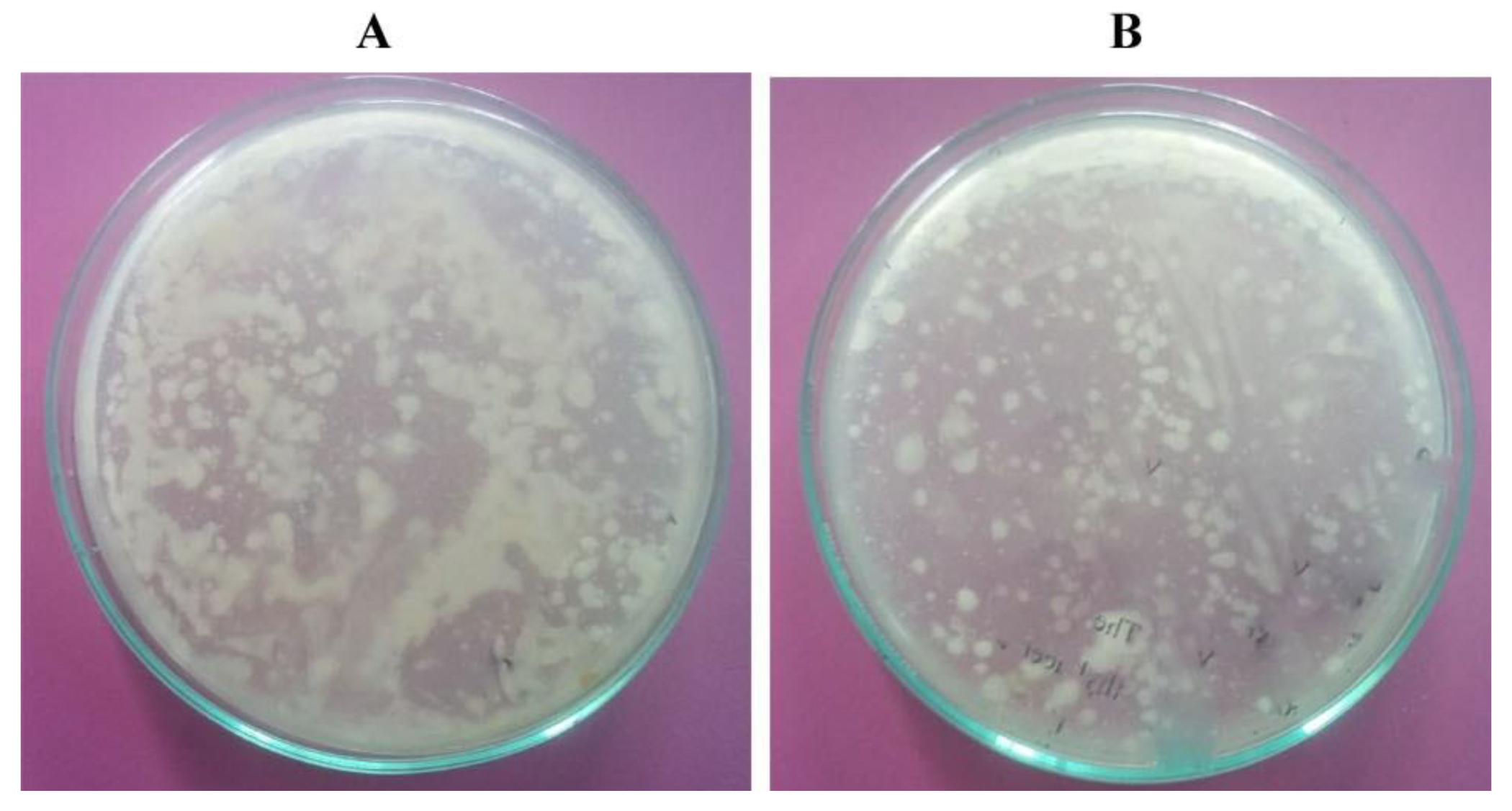
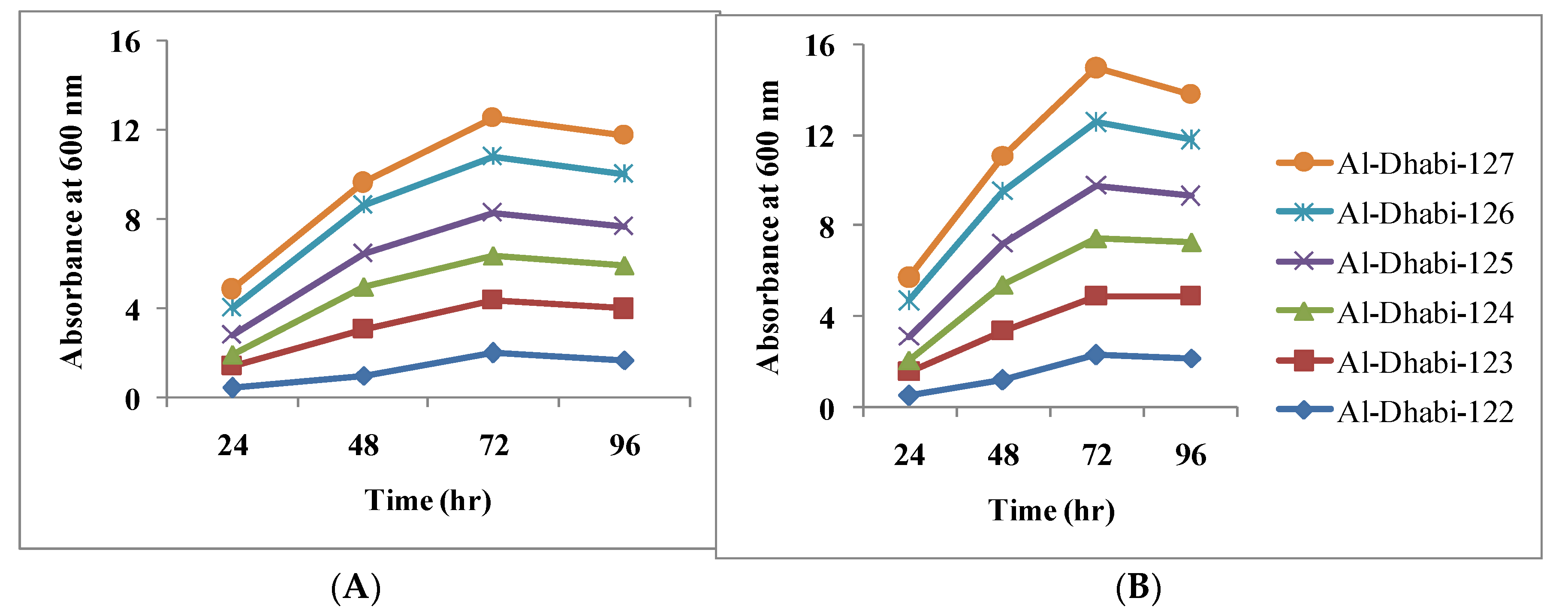
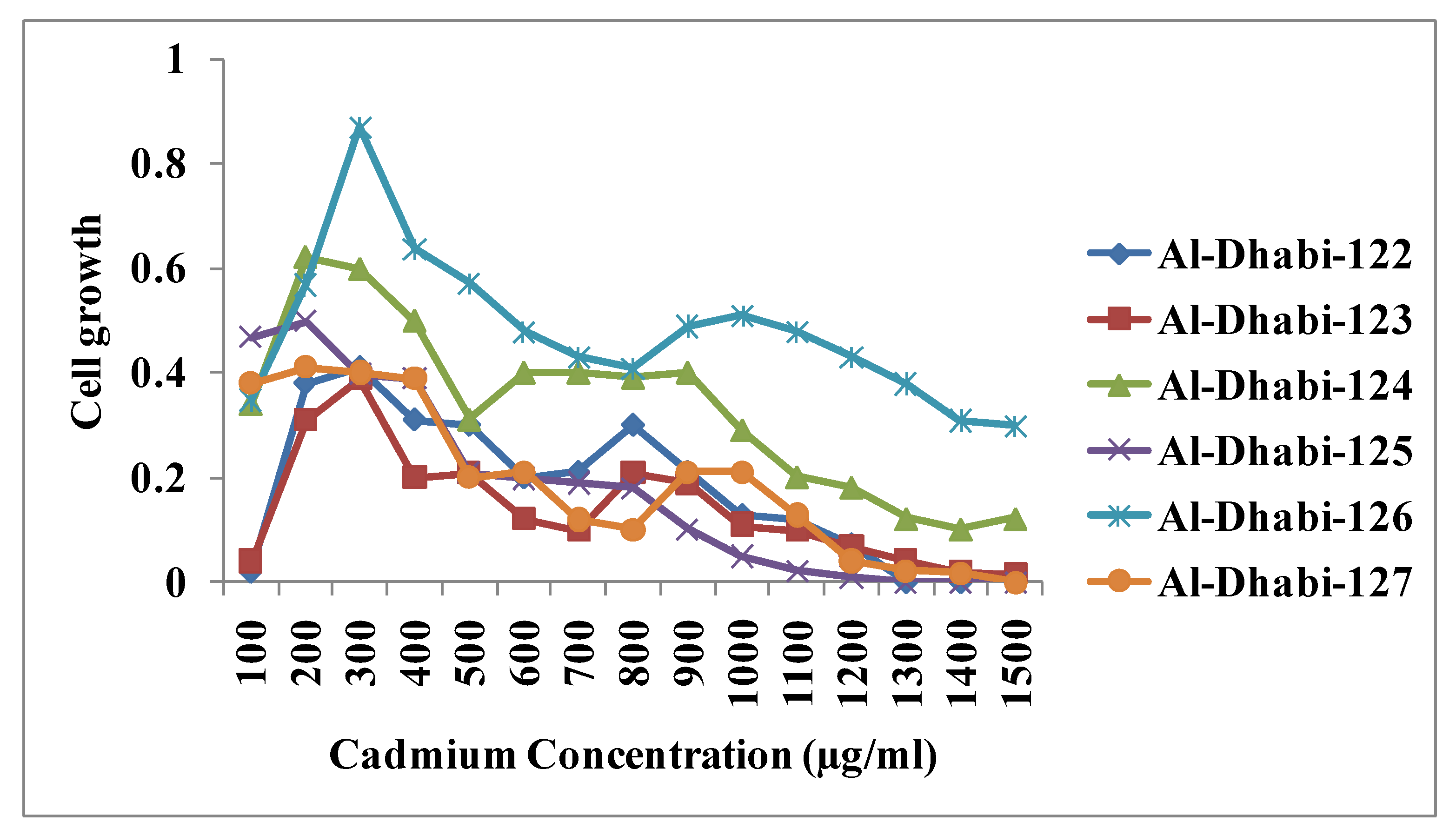
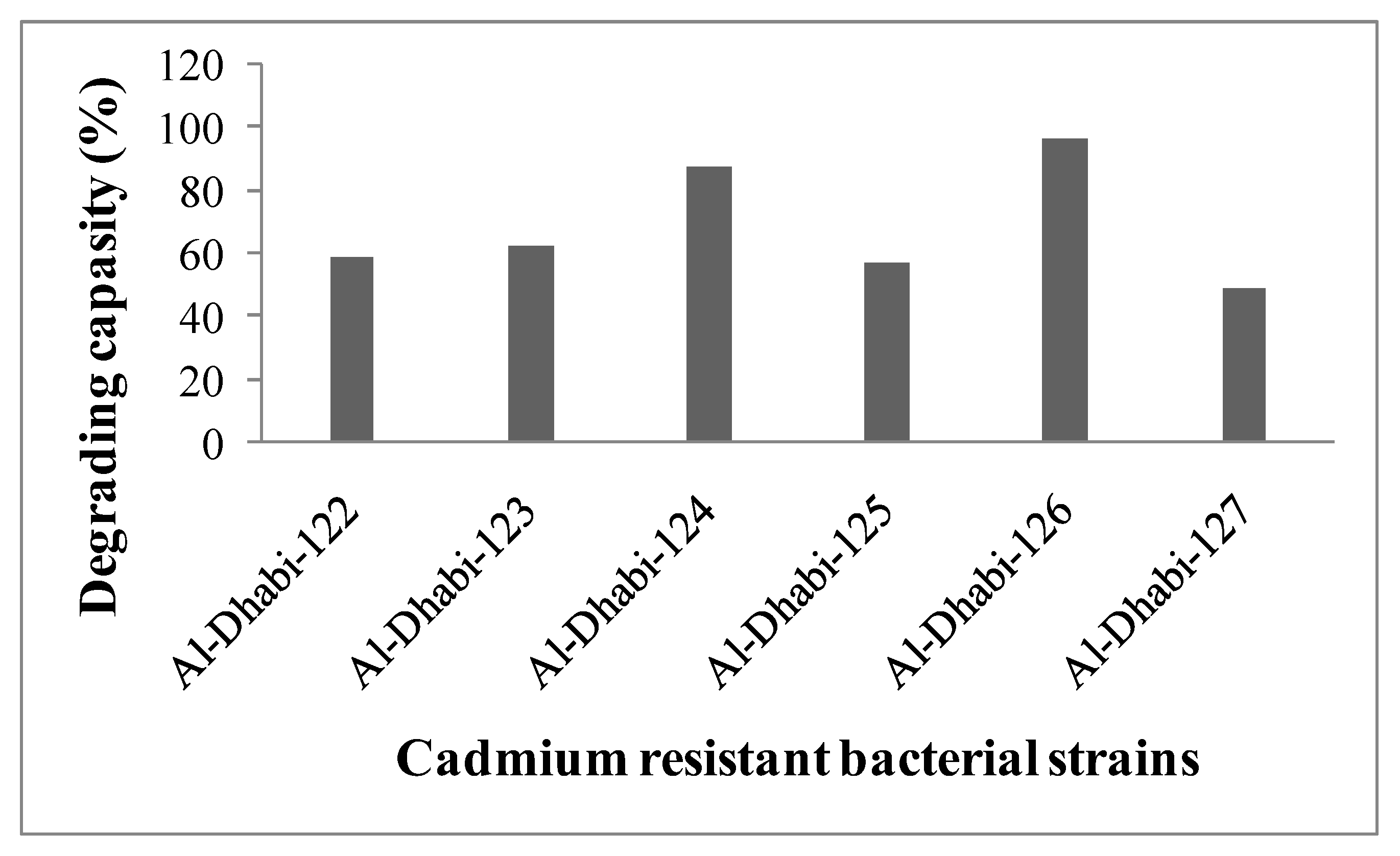
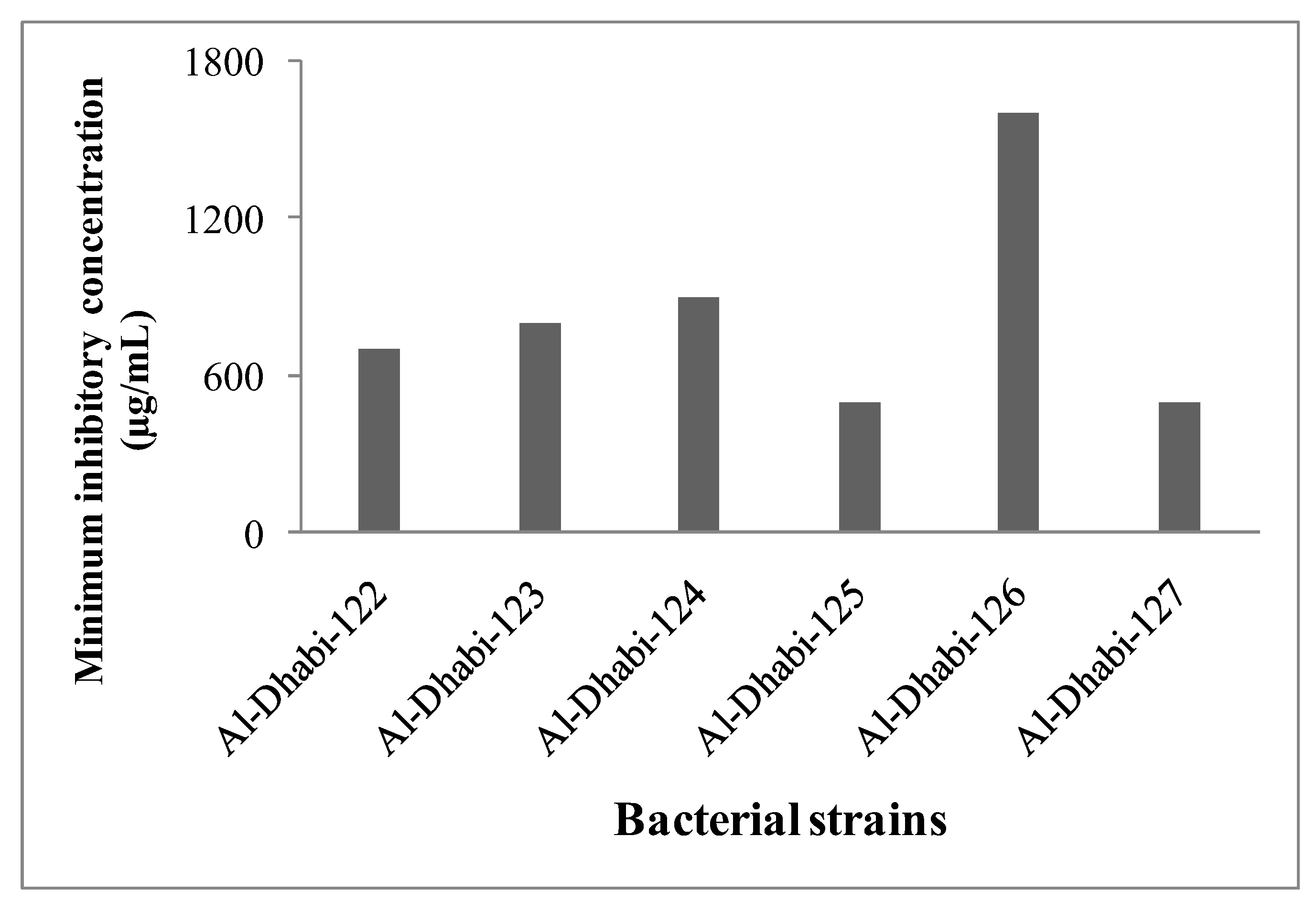
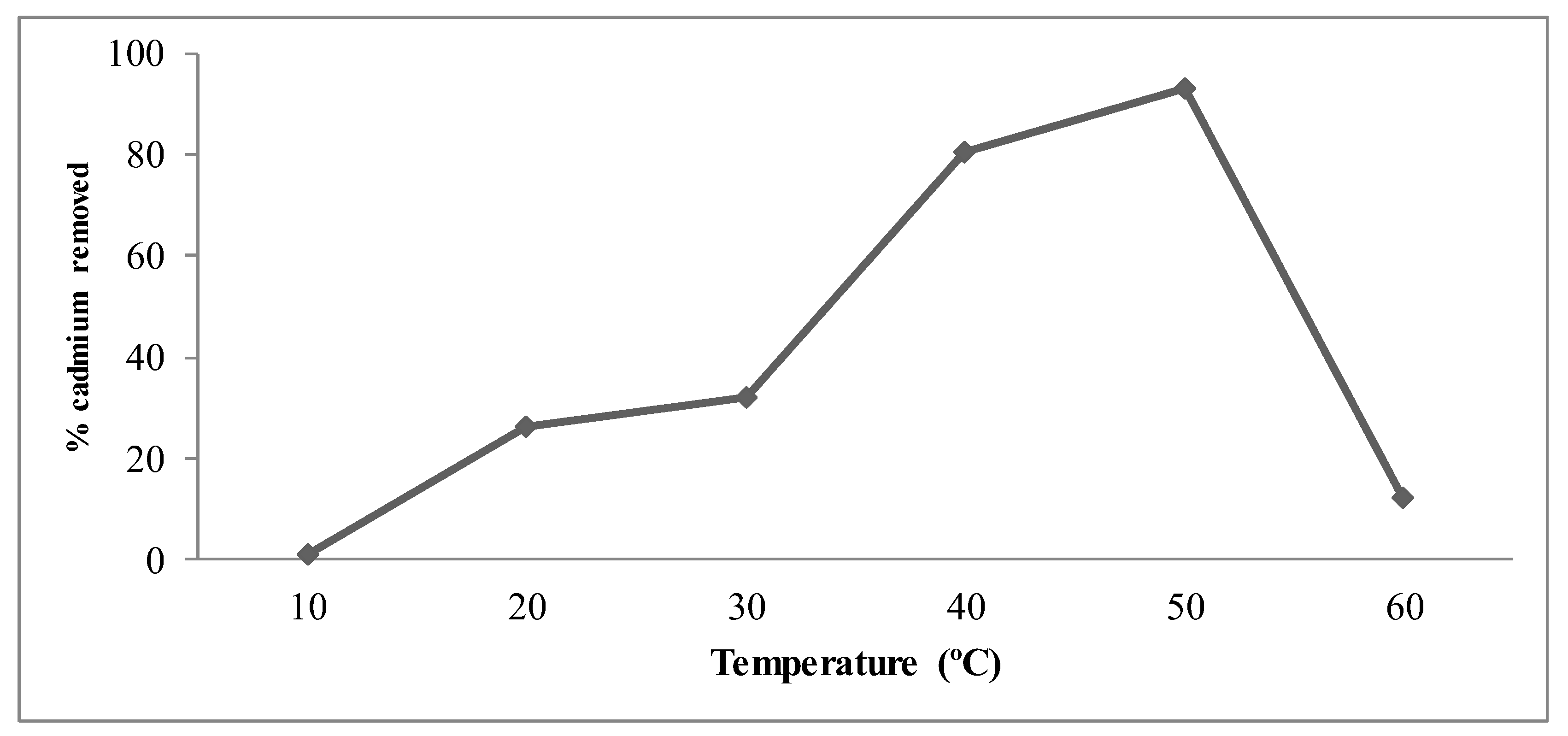

| Dilution | Control | Cd-Incorporated | Cd Resistant |
|---|---|---|---|
| Factor | LB Media | Bacteria (%) | |
| 10−1 | 13.2 × 102 | 4.3 × 102 | 32.5 |
| 10−2 | 8.2 × 103 | 2.1 × 103 | 25.6 |
| 10−3 | 1.2 × 104 | 0.67 × 104 | 55.8 |
| 10−4 | 0.6 × 105 | 0.33 × 105 | 55 |
| 10−5 | 0.31 × 106 | 0.13 × 106 | 41.9 |
| Tests | Bacterial Strains | |||||
|---|---|---|---|---|---|---|
| Al-Dhabi-122 | Al-Dhabi-123 | Al-Dhabi-124 | Al-Dhabi-125 | Al-Dhabi-126 | Al-Dhabi-127 | |
| Gram’s staining | + | + | - | + | + | - |
| Colony color | White | White milky | Whitish | White milky | White | Yellowish |
| Shape | Rod | Circle | Round | Rod | Rod | Round |
| Catalase | + | + | + | + | + | + |
| Oxidase | - | + | + | - | + | + |
| Indole | - | - | - | - | - | - |
| Citrate | - | + | + | - | + | + |
| Methyl-Red | - | - | - | + | + | - |
| Sucrose | + | + | - | + | + | - |
| Glucose | + | - | - | + | + | - |
| Xylose | + | - | - | - | - | + |
| Maltose | - | + | - | + | + | + |
| Lactose | - | + | - | + | - | - |
© 2019 by the authors. Licensee MDPI, Basel, Switzerland. This article is an open access article distributed under the terms and conditions of the Creative Commons Attribution (CC BY) license (http://creativecommons.org/licenses/by/4.0/).
Share and Cite
Al-Dhabi, N.A.; Esmail, G.A.; Mohammed Ghilan, A.-K.; Valan Arasu, M. Optimizing the Management of Cadmium Bioremediation Capacity of Metal-Resistant Pseudomonas sp. Strain Al-Dhabi-126 Isolated from the Industrial City of Saudi Arabian Environment. Int. J. Environ. Res. Public Health 2019, 16, 4788. https://doi.org/10.3390/ijerph16234788
Al-Dhabi NA, Esmail GA, Mohammed Ghilan A-K, Valan Arasu M. Optimizing the Management of Cadmium Bioremediation Capacity of Metal-Resistant Pseudomonas sp. Strain Al-Dhabi-126 Isolated from the Industrial City of Saudi Arabian Environment. International Journal of Environmental Research and Public Health. 2019; 16(23):4788. https://doi.org/10.3390/ijerph16234788
Chicago/Turabian StyleAl-Dhabi, Naif Abdullah, Galal Ali Esmail, Abdul-Kareem Mohammed Ghilan, and Mariadhas Valan Arasu. 2019. "Optimizing the Management of Cadmium Bioremediation Capacity of Metal-Resistant Pseudomonas sp. Strain Al-Dhabi-126 Isolated from the Industrial City of Saudi Arabian Environment" International Journal of Environmental Research and Public Health 16, no. 23: 4788. https://doi.org/10.3390/ijerph16234788
APA StyleAl-Dhabi, N. A., Esmail, G. A., Mohammed Ghilan, A.-K., & Valan Arasu, M. (2019). Optimizing the Management of Cadmium Bioremediation Capacity of Metal-Resistant Pseudomonas sp. Strain Al-Dhabi-126 Isolated from the Industrial City of Saudi Arabian Environment. International Journal of Environmental Research and Public Health, 16(23), 4788. https://doi.org/10.3390/ijerph16234788





